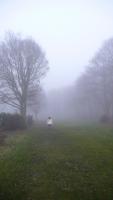Note: This entry has been restored from old archives.
This entry explores my journey from getting a Garmin eTrex Vista HCx GPS unit to generating a KML file that shows information I’ve gathered on my GPS via the Google Maps website (and, in theory, also Google Earth). It’s only lightly technical, more a review of the process than an instructional reference. I expect, and hope, there are more efficient ways to go about doing what I’ve done here.
I mentioned a little while ago that a recent addition to my toybox is a Garmin eTrex Vista HCx (AmazonUK). I’ve used this a lot over the last few months and am very happy with the purchase. The primary reason for having the device is that we like to ramble around the countryside a lot. A stint of Rogaining and Orienteering in high-school left me with very good map navigation skills, which have served me well. But when trekking around, especially moving at speed, referring to a paper map regularly can be a bit of an encumbrance. Enter the GPS, it fits in my hand and always tells me exactly where I am. There’s one important thing to be aware of though: it’d really not be so much use without a good map set.
The map set I have is Garmin TOPO Great Britain (AmazonUK). I don’t have much to compare it to in GPS-land. What I can say is that it is better for walkers than all the online mapping I’ve seen, except for those that use present sections of the Ordnance Survey maps (like MultiMap used to at high zoom levels, but it just seems to use Google Map data now). Additionally, this Garmin map is actually derived from the Ordnance Survey data. This is a huge bonus for walkers. Any UK rambler should know the greatness of the OS Explorer and Landranger maps sets. With the TOPO Great Britain maps on your GPS you’ll have the great feature that contours shown on the GPS unit are the same as those on the OS maps — making it very easy to place yourself on an OS map.
An OS map you say? Yes, I don’t consider the GPS to be a complete replacement. First, in deference to screen size, the maps are nowhere near as detailed as the OS maps. They have roads, water features, contours, and some terrain information — but they lack all the additional details found on the OS maps. The most important thing lacking on the Garmin map is full coverage of all the footpaths, bridleways, and byways marked on the OS maps. That sucks quite a bit.
The other obvious great features of this GPS unit are that it can store the path of your travels (you can save several tracks, I did this to map ski slopes and lifts individually in Ylläs), and you can mark waypoints for locations of interest. Then you can move this data between the unit and a PC. Walking geek heaven!
It isn’t all plain sailing though. Garmin sell their GPS units, and then want to make a ton more money on maps. As it comes the GPS isn’t a lot of use for walkers, it has only main roads loaded. So as well as spending more than 200 quid on the unit you’ll need to spend a further 100 quid for the UK maps. Ouch! There are a lot of complaints to be found on the web about this particular point, people don’t realise that the maps the Garmin units come with are rather crap. This seems to be a factor in a lot of negative reviews for the various eTrex units.
The eTrex Vista HCx I got is top of it’s line, you can spend a little less by getting one without a barometric altimeter and compass. Such as the Garmin eTrex Legend HCx, or one of the Cx models which are slower and less accurate than the HCx ones (but have longer battery life). Garmin actually provides a nice feature comparison tool on their site, here’s the eTrex models with SD card slots compared. The altimeter and compass are features that I’m a bit iffy about anyway, after three months of use. The altimeter needs regular recalibration and since you almost always have a, more accurate, 3D GPS lock it is redundant, and the compass doesn’t seem as stable as a “real” one.
You’ll also need to spend a little extra on a microSD/transFlash card. You don’t need a huge one though, I’m using a 256MB card and it fits the entire set of maps covering greater London in a fraction of it’s space. You could probably fit the entire map set in a 1GB card (a total guess). There’s not much point buying a new one that’s smaller than though, they’re as cheap as chips (har har) now. I picked up a 1GB one for about 8 quid (they’re 6 now) and put it into another device to free up the 256MB card.
The other stormy waters are around their MapSource software (“free” with the unit, thankfully) and their documentation is pretty crap. It’s isn’t abysmal, but as someone extremely familiar with the world of software my opinion is that it is firmly in the massive ranks of the “mediocre”. Of course, I’m also a Linux geek so using their software has an added disadvantage for me. I’d have to reboot into Windows to use it, maybe it’ll work in Wine? Maybe I’d rather be doing other things with my time?
Luckily for us Linux dweebs there are plenty of industrious monkeys out there pushing their valuable hours into great software! The biggest and hairiest monkey is Google. Their online maps setup is geek heaven, and Google Earth is software bling at it’s finest. Now, Google Earth can supposedly hook up with my GPS unit and make sweet love… if I pay for the non-free version that is. I don’t have anything against paying for this, but have refrained thus-far since I’ve had terrible problems getting Google Earth to even work on my Ubuntu or Debian systems. sigh
So, I need a bridge. This bridge is given to the world in the form of gpsbabel. It speaks several map-data and GPS-device languages fluently! Brilliant!
What I typically want to do with my GPS data is push it from the device to a format I can use to display the data on the Google Maps website. The desired format is Google’s “KML” (tutorial/examples), the same file format that drives Google Earth.
For purposes of demonstration the rest of this post uses my GPS unit with a load of tracks and waypoints on it I saved while I was in Finland, the goal is to get a neat map of the area I visited out of the Garmin and onto Google. I had other data on the device though, so I chose a lat-long point from one of my Finland waypoints and only grabbed data within a 200 mile radius of that point. To do this we employ the ‘garmin‘ driver to suck the data, the ‘radius‘ driver to filter out unwanted points, and the ‘kml‘ driver to poop the data out to a nice KML file:
:; gpsbabel -i garmin -f /dev/ttyUSB0 -w -t
-x radius,lon=24.171808,lat=67.604049,distance=200
-o kml,points=0 -F gpsbabel.kml
Note the ‘points=0‘, if you don’t do this you get a “waypoint” for every point in your tracklog. If you don’t need these it is best to avoid them, my KML file was 137kB without the points and 34MB with them, ouch!
Nothing is simple though. Now I want to prettify my KML. This involved going through by hand and editing the marker names and descriptions, and adding in CDATA HTML sections to embed links and images for waypoints. The former is mostly necessary since the GPS doesn’t let names be longer than 12 chars, not enough, and the transfer maps non-ascii characters (i.e. Unicode) to ‘$’. Note that for names you can use XML-permitted entities like & but not most HTML ones, for ä you can’t use ä you’ll need to use Unicode.
Now I want my own waypoint icons and path colours. This requires removing the styles set by gpsbabel and defining a set of your own. For example I want a style for markers that show hotels, I define this:
<Style id="waypoint_hotel">
<IconStyle>
<scale>1.2</scale>
<Icon>
<href>http://maps.google.com/mapfiles/ms/micons/lodging.png</href>
</Icon>
</IconStyle>
</Style>
There’s a useful link for the “standard” Google Maps icon set here.
I also want to define my own line widths and colours for different classes of track. Good to distinguish between walking routes and bus routes, especially good in this case for the different grades of ski slope! Here’s a sample line style:
<Style id="track_ski_easy">
<LineStyle>
<color>aaff3333</color>
<width>4</width>
</LineStyle>
</Style>
Note the <color> is not as the HTML-familiar would expect! The hex fields are ‘aabbggrr’, that’s aa=alpha, bb=blue, gg=green, rr=red. So a 50% transparent cyan line is actually 80ffff00. Such a simple thing, yet it breaks my rrggbb indoctrinated brain!
Oops! Height and distance data embedded in KML description fields by gpsbabel is in miles and feet, I hate miles and feet! Maybe gpsbabel can be asked to use metric units but I don’t see an obvious way to tell it to do so. (Update: Thanks to the “Chief (GPS)Babel-head” (see comments) I now know that the ‘kml‘ driver has a ‘units‘ argument, i.e. ‘units=m‘ — I didn’t RTFM well enough.) Anyway, I’ve just put loads of effort into customising my KML, so time to do it with perl, yeah, sure, ewww. shrug
perl -ne
'if (/(d*.d*) mi/)
{ $x = $1 * 0.3048; s/$1 mi/$x km/; print $_; }
else
{ print $_; }'
YllasAkasSkiHoliday-26.kml > YllasAkasSkiHoliday-27.kml
It took me a whole evening to work through all this and get my final KML. I hope it’ll be easier next time around. It certainly isn’t for everyone.
The best way to describe all the details is by example, so check out my full Ylläs Ski Trip KML for the gory internal details, and here’s a link to my Ylläs mapping data displayed by Google Maps. The iframe to the right (assuming you support iframes) is zoomed in on the part of the map data showing the ski slopes and lifts that I mapped. The dark grey lines are the lifts (recycle signs mark the bottom of the lift), the green (very easy) and blue (easy) lines are the slopes. It’s cool how my weaving back and forth (at speed) on the slopes is captured so well by the GPS!
In conclusion:
- It might look like horrid process, it might have taken a lot of effort, but I did enjoy it.
- That said, I hope that Google Earth can do this WYSIWYG style or something. That’d make this sort of thing much more friendly.
- Joy, one more dependency out of the way so I might get that write-up of the Yllä ski trip finished.
- Don’t forget than you can use
gpsbabelto upload data from KML files to your GPS too! - I wanted a topo map of Finland for the Garmin, I found it, but it makes the GB Topo map look cheap! At least you can buy it in parts, at the link given it is 99 euro per CD, and Finland is covered by 6 CDs.


